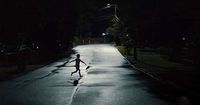When a film opens with a child’s voice calmly describing a town so shamed by a mysterious tragedy that its people buried the truth deep within themselves, you know you’re in for something unsettling. That’s precisely the atmosphere director Zach Cregger conjures in his sophomore feature, Weapons, now playing in theaters. Released in August 2025, the film has already been hailed as one of the year’s most riveting horror experiences, blending creeping dread, sly social commentary, and a sprawling, multi-perspective narrative reminiscent of Paul Thomas Anderson and John Carpenter, according to SKJ Bollywood News.
The story begins in the quiet Pennsylvania town of Maybrook, where, at 2:17 AM one fateful night, seventeen children vanish without a trace. The only thing they share? They’re all students in Justine Gandy’s (Julia Garner) classroom. The next morning, Justine finds a single child, Alex Tilly (Cary Christopher), sitting alone amid a sea of empty desks. The question that haunts the town: what happened to the rest of the kids?
As The Wire reports, the disappearance quickly becomes the town’s rawest wound. Parents, desperate for answers, lash out at Justine, even calling her a witch when she tries to express her remorse. Police interrogate both her and Alex, but the case remains maddeningly unsolved. The community’s shame and pain are palpable, their grief underscored by the mournful strains of George Harrison’s “Beware of Darkness.” Yet, as the opening voiceover warns, “this incident will never be solved.”
But Cregger, who burst onto the scene with his debut Barbarian in 2022, refuses to let the narrative stagnate. He spins the story through a kaleidoscope of perspectives: Justine, the embattled teacher; Archer Graff (Josh Brolin), a grieving father determined to find his missing son; Paul Morgan (Alden Ehrenreich), a local cop struggling with sobriety and a crumbling marriage; Marcus (Benedict Wong), the middle school principal trying to help Justine weather the storm; James (Austin Abrams), a heroin addict who stumbles into the mystery during a burglary; and Alex, whose perspective ultimately fills in the missing pieces. Each viewpoint drags the timeline slightly back, then pushes it forward, building suspense and deepening the emotional stakes.
What truly happened to the children, though? According to SKJ Bollywood News, the answer is as bizarre as it is chilling. In the dead of night, the children were compelled by a supernatural power spell to leave their homes and run to Alex’s house. There, his “aunt” Gladys (Amy Madigan)—who is, in fact, a witch—collected the children to perform a life-draining ritual meant to keep herself alive. Alex, under her sway, had stolen a personal item from each child, an essential ingredient for Gladys’s dark magic.
The police, led by Paul Morgan, investigate Gladys’s home but come up empty-handed; she’s hidden the children too well. It’s Anthony, the local drug addict, who accidentally discovers the kids while breaking into the house. He alerts Morgan, and together they attempt a rescue, only to fall under Gladys’s spell themselves. The situation deteriorates rapidly: Miss Gandy is forced to kill Morgan, her former lover, and Graff has to subdue Anthony, who is ultimately shot by Gandy with Morgan’s service weapon.
In a desperate act, young Alex turns the tables. Using the witchcraft techniques he’s learned from Gladys, he possesses the other children, this time directing their collective rage against his aunt. What follows is a harrowing, go-for-broke sequence: the children, in a trance, chase Gladys through the neighborhood, smashing through glass and tearing apart homes. Ultimately, they catch her and, in a frenzy, rip her to pieces—one child even pulls half her head off. The violence is shocking, but it’s not cathartic. Afterward, most of the children fall into a catatonic state, though a few begin to speak again. Archer Graff finds his son and walks away with him in the film’s closing moments, but there’s no sense of triumph—just the heavy residue of trauma.
What does it all mean? Both The Wire and SKJ Bollywood News highlight the film’s potent allegorical power. Weapons is not just a horror story about possession and witches; it’s a searing reflection on how communities process tragedy—especially tragedies involving children. The empty classroom and grieving parents evoke the aftermath of school shootings, while the supernatural elements serve as a metaphor for the “magical thinking” that often follows such events. Rather than confront the root causes of their pain, the townsfolk bury the truth, hoping it will simply go away. As the film’s narrator observes, “these traumas are something to be wished away… but the pain, the death, all of that suspicion, it seeps into the ground, gets into the water, and will be felt for decades to come.”
Cregger’s direction never lets viewers escape the emotional reality of his characters. Even as the film veers into occult territory, the wounds of the protagonists remain front and center. The script refuses to offer easy answers or neat resolutions. Instead, Cregger invites the audience to sit with the discomfort, to ponder the true cost of denial and the dangers of inflexible ideology. In fact, as The Wire points out, the film’s antagonist—Gladys—can be read as a metaphor for “inflexible ideology,” the kind that weaponizes good intentions and drives communities to destroy those who disagree.
This approach places Weapons firmly within the so-called “elevated horror” tradition, alongside the works of Jordan Peele, Robert Eggers, Ari Aster, Jennifer Kent, and Osgood Perkins. Like those filmmakers, Cregger uses supernatural stories to explore urgent real-world metaphors, ensuring horror isn’t dismissed as mere schlock. Yet, he also injects moments of satire and farce, shifting gears between horror, drama, action, and even humor—sometimes within the same scene. It’s a bold, assured voice that marks Cregger as an auteur worth watching.
While some critics argue Weapons doesn’t reach the cathartic heights of Barbarian, there’s no denying the film’s impact. Its refusal to provide closure mirrors the real-world aftermath of collective trauma, where, more often than not, there is no neat resolution. Instead, the scars linger, shaping the community for generations.
With its intricate storytelling, haunting allegory, and emotional depth, Weapons stands as a testament to the power of horror to reflect—and challenge—the anxieties of our times. As viewers leave the theater, they’re left with more questions than answers, and perhaps that’s exactly the point. After all, some wounds never truly heal; they simply become part of the landscape.





